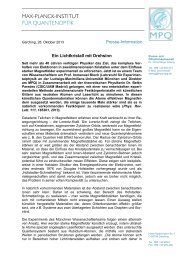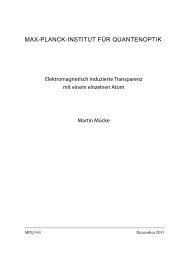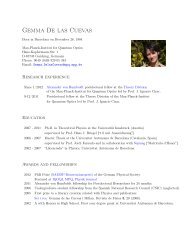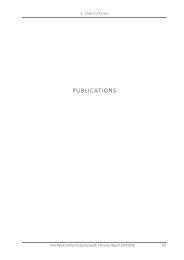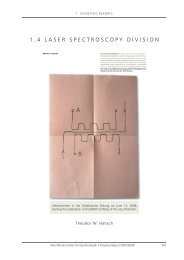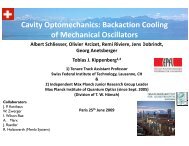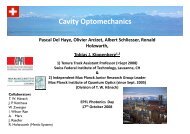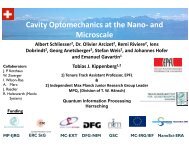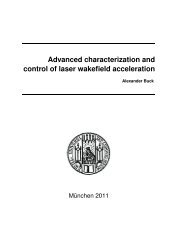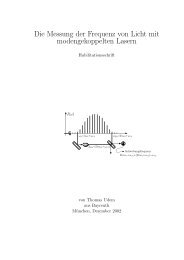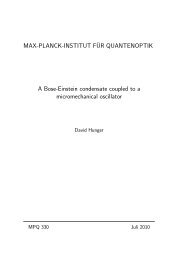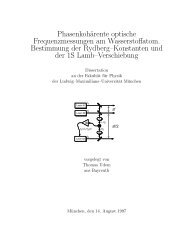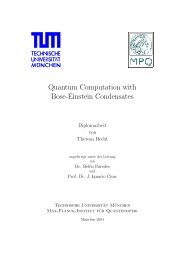Attosecond Control and Measurement: Lightwave Electronics
Attosecond Control and Measurement: Lightwave Electronics
Attosecond Control and Measurement: Lightwave Electronics
Create successful ePaper yourself
Turn your PDF publications into a flip-book with our unique Google optimized e-Paper software.
1 . 3 AT T O S E C O N D A N D H I G H - F I E L D P H Y S I C S D I V I S I O N<br />
Dispersion management for a sub-10-fs, 10 TW<br />
optical parametric chirped-pulse amplifier<br />
Franz Tavella, 1,4 Yutaka Nomura, 1 Laszlo Veisz, 1 Vladimir Pervak, 2 Andrius Marcinkevi~ius, 1,3,5 <strong>and</strong><br />
Ferenc Krausz 1,2<br />
1 Max-Planck-Institut für Quantenoptik, Hans-Kopfermann-Strasse 1, 85748 Garching, Germany<br />
2 Department für Physik, Ludwig-Maximilians-Universität München, am Coulombwall 1, 85748 Garching, Germany<br />
3 Present affiliation, IMRA America Inc., 1044 Woodridge Avenue, Ann Arbor, Michigan 48105, USA<br />
4 franz.tavella@mpq.mpg.de<br />
5 amarcink@imra.com<br />
Received March 19, 2007; revised June 6, 2007; accepted June 11, 2007;<br />
posted June 11, 2007 (Doc. ID 81025); published July 24, 2007<br />
We report the amplification of three-cycle, 8.5 fs optical pulses in a near-infrared noncollinear optical parametric<br />
chirped-pulse amplifier (OPCPA) up to energies of 80 mJ. Improved dispersion management in the<br />
amplifier by means of a combination of reflection grisms <strong>and</strong> a chirped-mirror stretcher allowed us to recompress<br />
the amplified pulses to within 6% of their Fourier limit. The novel ultrabroad, ultraprecise dispersion<br />
control technology presented in this work opens the way to scaling multiterawatt technology to even<br />
shorter pulses by optimizing the OPCPA b<strong>and</strong>width. © 2007 Optical Society of America<br />
OCIS codes: 190.4970, 190.4410, 320.5520.<br />
High-peak-power few-cycle sources are of interest for<br />
a number of applications in nonlinear optics, highfield,<br />
<strong>and</strong> ultrafast science [1]. Few-cycle pulses not<br />
only offer high peak powers from compact systems<br />
(relative value) but also enable the emergence of entirely<br />
new technologies such as the generation <strong>and</strong><br />
measurement <strong>and</strong> spectroscopic applications of isolated<br />
attosecond pulses <strong>and</strong> steering the atomic-scale<br />
motion of electrons with controlled light fields [2–7]<br />
(absolute value). Noncollinear optical parametric amplification<br />
offers amplification over spectral ranges<br />
sufficiently broad for few-cycle pulse synthesis, but<br />
dispersion control during stretching <strong>and</strong> recompression<br />
has remained a major challenge because of the<br />
large b<strong>and</strong>width over which the dispersion needs to<br />
be compensated with high accuracy. This is one of the<br />
reasons why many terawatt-scale optical chirpedpulse<br />
amplifiers [8,9] are designed for higher energy<br />
amplification <strong>and</strong> for pulse durations longer than<br />
those potentially allowed by the amplification b<strong>and</strong>width.<br />
Only recently amplification <strong>and</strong> adaptive<br />
pulse compression of more than 100-THz b<strong>and</strong>widths<br />
to the few-cycle regime were demonstrated reaching<br />
the terawatt regime [10–12].<br />
In this Letter we report the implementation of an<br />
ultrabroadb<strong>and</strong> grism-pair stretcher capable of controlling<br />
group delay over a dynamic range of tens of<br />
picoseconds <strong>and</strong> a b<strong>and</strong>width exceeding 100 THz.<br />
This improvement led to what we believe to be the<br />
first sub-10-fs, 10 TW light source ever reported <strong>and</strong><br />
holds promise for further shortening of multiterawatt<br />
light pulses by means of optical parametric amplifier<br />
(OPA) b<strong>and</strong>width engineering.<br />
The schematic layout of the our novel stretchercompressor<br />
system is depicted in Fig. 1. The OPA<br />
chain is described in previous work [12]. Stretching is<br />
implemented by the negative dispersion of a pair of<br />
grisms [13]. These hybrid elements combining the<br />
dispersive effects of diffraction gratings <strong>and</strong> prisms<br />
were recently demonstrated to be capable of introduc-<br />
August 1, 2007 / Vol. 32, No. 15 / OPTICS LETTERS 2227<br />
ing near-linear dispersion with high throughput over<br />
a b<strong>and</strong>width of 60 nm in the near infrared [13–15].<br />
Here we demonstrate that they can also control optical<br />
delay efficiently over a b<strong>and</strong>width of 300 nm in<br />
the same spectral range. Our positive-dispersion<br />
compressor is composed of glass blocks <strong>and</strong> chirped<br />
mirrors (CM2). The latter are used for final compression<br />
to prevent excessive nonlinear effects in the<br />
glass compressors. Residual higher-order dispersion<br />
of the system is compensated by another pair of<br />
chirped mirrors (CM1) <strong>and</strong> a programmable acoustooptic<br />
dispersive filter (AODF), dubbed Dazzler [16].<br />
The grism stretcher is designed to compensate for<br />
the dispersion of (1) the glass compressor (160 mm of<br />
SF57 <strong>and</strong> 100 mm of fused silica), (2) the BBO crystals<br />
in the optical parametric chirped-pulse amplifier<br />
(OPCPA) chain (a total of 15-mm path length), <strong>and</strong><br />
(3) the acousto-optical filter (43 mm of TeO 2) at the<br />
central wavelengths of 850 nm of our amplifier chain.<br />
Fig. 1. Optical layout of the OPCPA experimental setup.<br />
0146-9592/07/152227-3/$15.00 © 2007 Optical Society of America<br />
172 Max-Planck-Institut für Quantenoptik • Progress Report 2007/2008



